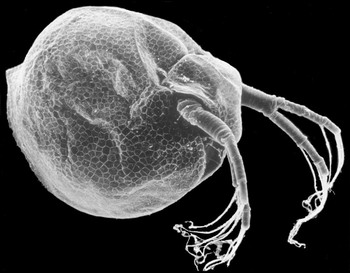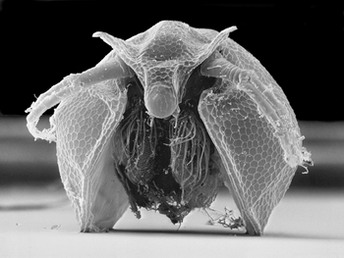

CLADOCERANS (WATER FLEAS) OF BRITISH COLUMBIA

Ceriodaphnia dubia, scanning electronmicroscope photo
by Gordon Green
Key to the Cladocerans of British Columbia
Visit our Cladoceran photo gallery.
Introduction
by
Gordon Green, Royal British Columbia Museum
Cladocerans are small crustaceans belonging to the orders, Anomopoda, Ctenopoda, Onychopoda or Haplopoda. Commonly called water fleas, due to their small size and jerky swimming motion, cladocerans are extremely abundant in most freshwater habitats. There are a few estuarine species but this group has not been successful in the oceans. Some species are planktonic living in the open water of lakes, while others live on or near the bottom or on aquatic vegetation. Some species are found primarily in small ponds or saline lakes which lack fish predators.
Cladocerans have a single compound eye and often a smaller secondary eye, the ocellus. A carapace covers the body, including the 4 to 6 pairs of thoracic appendages, and is used as a brood chamber. The abdomen and postabdomen are generally bent forward under the thorax. The postabdomen bears two large claws used primarily for cleaning debris out of the carapace. Swimming is accomplished by downward strokes of the large second antennae.
There are approximately 150 known species in North America, and it is not uncommon to collect 10 or more species in a small area of lake bottom. A few species are predacious but most are herbivores or detritivores, feeding on phytoplankton, attached vegetation or decaying organic material. In most planktonic species complex movements of the thoracic appendages produce a constant current of water between the valves. Small particles in the water are filtered out by fine setae on the thoracic legs and moved along a groove at the base of legs to the mouth. Although there is some evidence that certain types of food, such as particular types of algae, Protozoa, or bacteria may be selected by some species, it is generally believed that all organic particles of suitable size are ingested without any selective mechanism. When undesirable material or large tangled masses are introduced between the mandibles, they may be removed by spines on the first legs and then kicked out of the carapace by the postabdomen.

Ceriodaphnia acanthina, photo by Gordon Green
An important link in food chains of virtually every inland body of water, cladocerans convert phytoplankton, benthic plants and decaying organic matter into animal tissue that can be used by larger animals. In large lakes they are a major food source for many kinds of fish such as sticklebacks, minnows and young Sockeye salmon. Many aquatic insect larvae and other invertebrates also feed on cladocerans.
Because of their large numbers cladocerans consume vast amounts of organic material, and by reducing the amount of phytoplankton are important in maintaining water clarity in many lakes. Littoral cladocerans are typically the most abundant animals on lake bottoms and are one of the prime converters of decaying organic matter with its associated micro-organisms into a form usable by fish and larger invertebrates.
Most cladocerans can reproduce by parthenogenesis, females producing eggs that develop into young without fertilization by males. As a result, males are not present in the population for much of the year. As long as environmental conditions remain favourable females will continue to reproduce in this manner, producing only female offspring capable of asexual reproduction. If environmental conditions deteriorate due to overcrowding, lack of food or oxygen depletion, eggs are produced that develop into males, and females capable of sexual reproduction. These females have modified carapaces which are thicker and darker dorsally than a regular carapace and produce haploid eggs that must be fertilized by the males. The fertilized egg goes through several cell divisions the zygote enters a resting stage and cell division stops. The thick dorsal portion of the carapace, the ephippium, containing the resting embryos, is shed when the female next moults. These embryos protected by the ephippium are capable of surviving extended periods of unfavourable conditions such as drying or freezing. In this manner cladoceran populations survive through winter and periods of drought. When environmental conditions are again favourable the embryos develop and break free of the ephippia. The ephippia are also used as a means of dispersal for many species, being carried by the wind or in the fur, feathers or digestive tracts of animals to new habitats.
Some cladoceran species, especially species in the genus Daphnia, show a high degree of morphological variability. Head shape, length of tail spine and size of body may all vary considerably within a species.
There is still considerable work that needs to be done on this group to establish basic taxonomic and distributional information.
Please cite these pages as:
Author, date, page title. In: Klinkenberg, Brian. (Editor) 2023. E-Fauna BC: Electronic Atlas of the Fauna of British Columbia [www.efauna.bc.ca]. Department of Geography, University of British Columbia, Vancouver. [Date Accessed]
© Copyright 2023 E-Fauna BC.